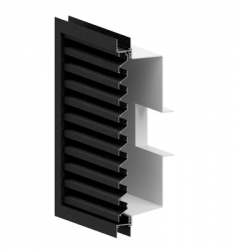Warning: Are your louvres non-compliant?

Posted on 06/09/2023
Renson UK National Sales Manager Martin Daniels explains how honest testing isn’t always as transparent as it should be…
When specifying louvres for architectural projects, it’s imperative that the products selected are of the highest quality.
At Renson UK, we’ve spent the past 50 years designing, developing and manufacturing high-performance ventilation products, supplying fully tested, high-quality louvres and mechanical ventilation products for every application.
It’s during this time that we’ve come across many non-compliant louvres in the market – and it all comes down to testing.
The British and European Standard
The industry standard for weather testing of louvres in the UK was developed by the Building Services Research and Information Association (BSRIA) in collaboration with the Heating, Ventilation and Air Conditioning Manufacturers Association (HEVAC), and was adopted in 2001 as British and European Standard: BS EN 13030:2001.
Since then, BS EN 13030:2001 has tested louvres in three key performance areas – water penetration, or the ability to prevent rain penetrating the louvre; pressure drop, or how freely the louvre allows air to pass through; and overall performance, a combined measure of both.
The tests themselves simulate the real-life operating conditions that a louvre will undergo when installed, enabling clients to compare one manufacturer’s performance against another at set benchmarks, helping to make specification easier.
Water penetration
During the water penetration test, the louvre is subjected to a simulated rainfall rate of 75l/h and a wind speed of 13m/s (30mph). The rejected water is collected in the weather section, and water in the collection duct is measured to calculate the percentage of water penetrated through the louvre. In addition to the simulated wind at 13m/s, air is drawn through the louvre at 0, 0.5, 1.0, 1.5, 2.0, 2.5, 3.0 and 3.5m/s to simulate inlet ventilation rates.
The problem is, the BS EN 13030:2001 test does not measure or give consideration to the way the water is collected, and it’s therefore easy to get away with placing an abnormally large collection plate behind the louvre simply for the sake of the test.
Therefore when comparing different louvres, it is important to obtain a full copy of the test report – a full report will show if any large collection trays were incorporated to catch penetrated water before being measured.
Honest testing
Because of this loophole in the BS EN 13030:2001 test, we’ve seen a countless number of louvres being approved and highly rated, but that end up being non-compliant, and at Renson, the last thing we want to do is let our customers down with an inferior product.
We therefore provide all our customers with full test reports for complete transparency – additionally, all our test reports are freely and easily downloadable from our website.
We have a commitment to providing our customers with the best, most reliable, and comprehensively tested products in today’s market, so for your next louvre project, use Renson UK for peace of mind – and above all, confidence.
For more information, visit https://www.renson.eu/en-gb/for-professionals/contact

